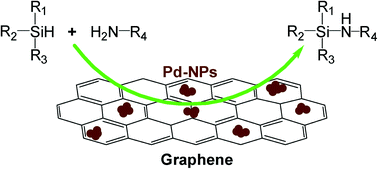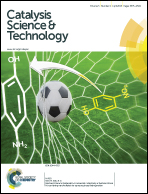Palladium nanoparticles supported on graphene as catalysts for the dehydrogenative coupling of hydrosilanes and amines†
Abstract
Palladium nanoparticles (Pd NPs) were supported on undoped and N- or B-doped graphenes (Gs) and these materials have been used as catalysts for the dehydrogenative coupling of hydrosilanes and amines to form silazanes. Working under optimal conditions, a conversion over 99% and a selectivity of 84% were achieved for the reaction of dimethylphenylsilane with morpholine. In contrast, copper (Cu NPs) or nickel nanoparticles (Ni NPs) supported on G did not promote the formation of the corresponding Si–N coupling product. It was found that Pd/G performed better for this coupling than analogous catalysts, in which Pd NPs were supported on active carbon, multiwall carbon nanotubes or diamond NPs. Pd/G as a catalyst has a wide substrate scope, including aliphatic and aromatic amines and mono or dihydrosilanes. Pd/G undergoes a gradual deactivation due to the growth and partial agglomeration of Pd NPs and the aggregation of G sheets, as observed by TEM.


 Please wait while we load your content...
Please wait while we load your content...